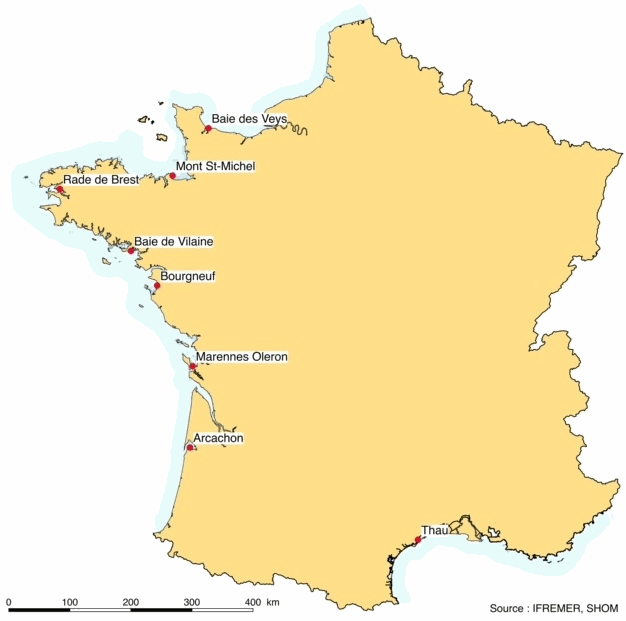Copy this text
ECOSCOPA network : high frequency environmental database
Based on the consolidation of the Ifremer networks RESCO (https://doi.org/10.17882/53007) and VELYGER (https://doi.org/10.17882/41888), the general objective of the ECOSCOPA project is to analyze the causes of spatio-temporal variability of the main life traits (Larval stage - Recruitment - Reproduction - Growth – Survival – Cytogenetic anomalies) of the Pacific oyster in France and follow their evolution over the long term in the context of climate change.
The high frequency environmental data are monitored since 2010 at several stations next to oyster farm areas in eight bays of the French coast (from south to north): Thau Lagoon and bays of Arcachon, Marennes Oléron, Bourgneuf, Vilaine, Brest, Mont Saint-Michel and Veys (see map below). Sea temperature and practical salinity are recorded at 15-mins frequency. For several sites, fluorescence and turbidity data are also available.
Data are acquired with automatic probes directly put in oyster bags or fixed on metallic structure at 50 cm over the sediment bottom, except for Thau Lagoon whose probes are deployed at 2m below sea surface. Since 2010, several types of probes were used: STP2, STPS, SMATCH or WiSens CTD from NKE (www.nke-instrumentation.fr) and recently ECO FLNTU (www.seabird.com). The probes are regularly qualified by calibrations in the Ifremer coastal laboratories.
Precision estimated of the complete data collection process is: temperature (±0.1°C), salinity (±0.5psu), in vivo fluorescence (±10%), turbidity (±10%). The data are qualified into several levels: 0-No Quality Check performed, 1-Good data, 2-Probably good data, 3-Probably bad data, 4-Bad data, 5-Value changed, 7-Nominal value, 8-Interpolated value, 9-Missing value.
Disciplines
Biological oceanography, Physical oceanography
Keywords
High frequency, coastal monitoring, sea temperature, practical salinity, fluorescence, turbidity
Location
43.367142N, 43.359246S, 3.569481E, 3.557415W
44.666046N, 44.660641S, -1.131045E, -1.138645W
48.335676N, 48.334031S, -4.321795E, -4.324494W
49.376199N, 49.37011S, -1.100724E, -1.108739W
47.042382N, 47.034395S, -1.993755E, -2.004172W
47.514873N, 47.508026S, -2.624347E, -2.634484W
48.665424N, 48.648235S, -1.812817E, -1.846274W
45.863779N, 45.852782S, -1.174179E, -1.18646W
Devices
NKE (www.nke-instrumentation.fr)
SMATCH with localized chlorination, frequency rotation: 4 months
SP2T / STPS / WiSens CTD with rotation: fortnightly in productive period otherwise monthly.
SeaBird (www.seabird.com)
WetLab ECO FLNTU : Optical sensors which measure chlorophyll fluorescence at 470 nm and turbidity at 700 nm within the same volume. 5 measures at 1Hz every 15 mins. Fluorescence range 0-50 FFU with 0.01 FFU sensitivity / Turbidity range 0-100 NTU with 0.02 NTU sensitivity. No rotation needed, global maintenance at SeaBird facilites every two years.


